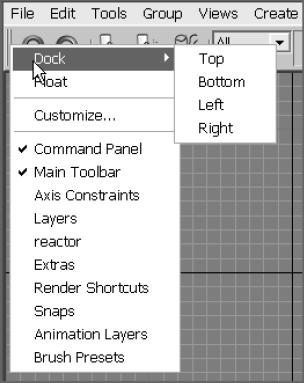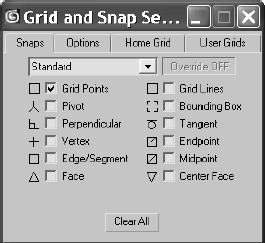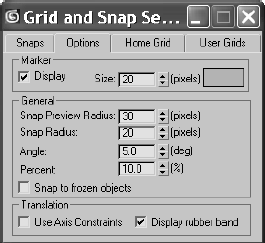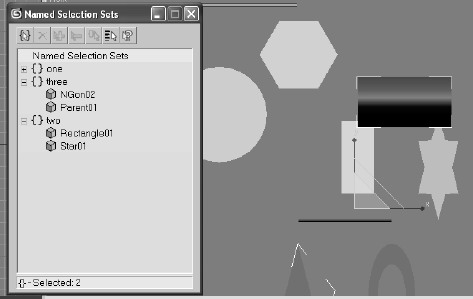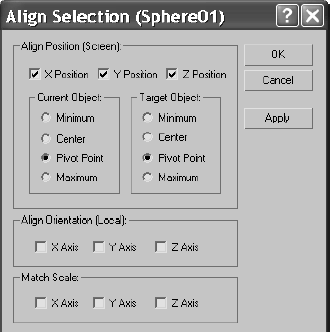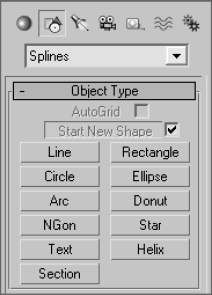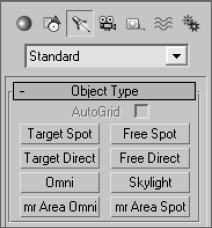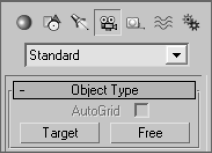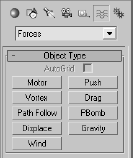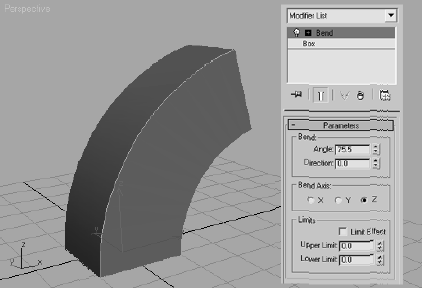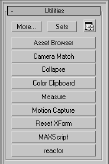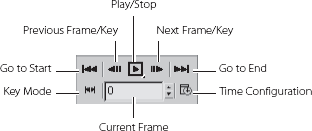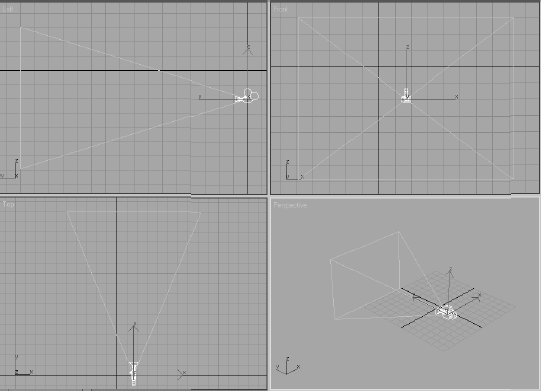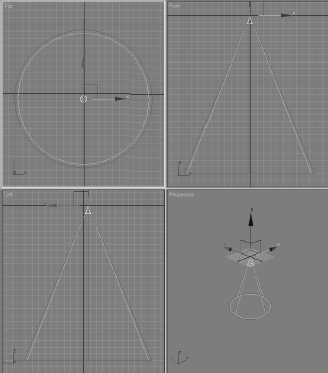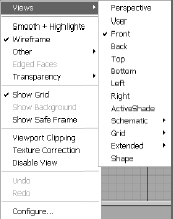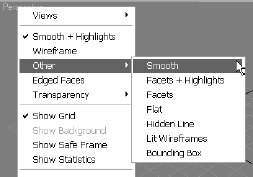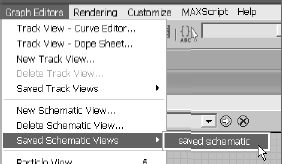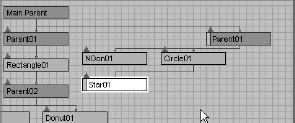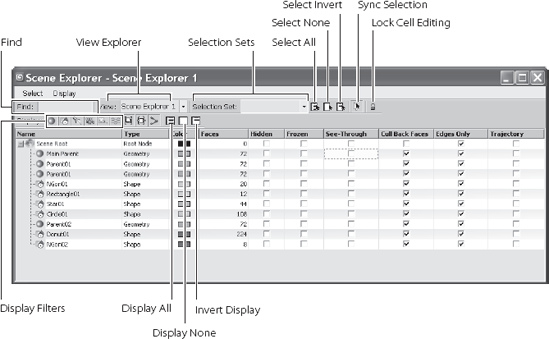This chapter explains the 3ds Max interface and its most commonly used windows and panels. You already mucked about in the UI when you built your mobile in the previous chapter. This chapter will go into more depth regarding some of the tasks you performed, and it will give you a layout of where things are and what they do. Furthermore, we'll take a look at the commonly used windows and panels in 3ds Max and see how to operate them.
You can use this chapter as a reference as you work through the rest of this book. As you progress, you might want to check back here to review some of the information. It's important to be in front of your computer when you read this chapter, so you can try things out as we discuss them in the book.
Topics in this chapter include:
What Am I Looking At?
Screen Layout
Command Panels
Controls at the Bottom of the UI
The Viewports
Managing Scene Objects
Scene Explorer
When you start up 3ds Max, you will be looking at a screen full of buttons, icons, menus, and panels and an empty work area—how daunting! Although it may seem that there is no end to the switches and levers in 3ds Max, you'll be able to master the UI with just a little experience. The more you use 3ds Max to create, the more comfortable you'll become with the UI and all of its nuances. Before you know it, the UI will be a nonissue for you— just give it time and patience.
As with many other 3d applications, almost any command or tool can be accessed at least a few different ways. For example, you can access some tools through icons in the Command panel by selecting them from the menu bar, by pressing a hot key, or by using context-sensitive Quad menus that appear when you right-click in the interface.
With so many different ways to perform any single function, how can you keep it all straight? Having a function or tool in several different places may seem like overload, but ultimately it gives users the most freedom to discover their preferred workflow. You may prefer to work mostly through the Command panel; others may find the menu bar easier to use. In either case, it's important to first experience the most common way to use 3ds Max and then branch out and find your own preference. In this book, we will first present the most obvious way to access a function; later we will give you alternative ways (such as hot keys) that you can use to access that feature.
Please don't obsess about all the information you're about to encounter. It's best to peruse this chapter at your own pace in front of your PC. Don't worry about memorizing all the information on every button and panel. Each of the exercises in this book contains short descriptions of the UI elements you'll use in that exercise. You can always refer back to this chapter for a more thorough explanation of a particular element. You should read through this chapter once to become familiar with where everything is and how everything works. Experience—and only experience—will show you how to make the tools work effectively; this chapter just shows you where they are.
In this chapter, you will find a fairly comprehensive explanation of 3ds Max's UI that expands on what you learned in Chapter 2, "Your First Max Animation." If you skipped Chapter 2, please go back to it now and read the section called "The Max Interface" for a run-through of how to work in 3ds Max's UI. Because experience will teach you so much more than just reading a text, it's wise to give the UI a whirl. Go ahead and click on things and move around in the UI using this and the previous chapter as a guide.
Let's take a quick look at how the screen is laid out. Figure 3.1 shows the initial 3ds Max screen.
The menu bar runs across the top of the 3ds Max UI, just as with many other applications. Here you can access tons of features to help you with your scene creation and manipulation. Immediately under the menu bar is the main toolbar, which contains the most frequently accessed tool icons. Everything from Undo to Render is in the main toolbar for easy access.
Running down the right side of the 3ds Max UI is the Command panel. Object creation and manipulation tools are gathered here for your access. The Command panel, as you discovered in the previous chapter, is divided into tabs. Each tab has its own specific panel of tools, ranging from Create to Utilities.
The meat of the UI is in the viewports. These portals give you access to 3ds Max's 3D space through orthographic and perspective views. These viewports are where you'll do the bulk of your work. By using mouse and key combinations, as you saw in the previous chapter, you can navigate through 3D space and around your scenes quite easily.
Running across the bottom of the UI are the tools for changing time values (such as the Time slider, which you experienced in the previous chapter), viewport navigation controls, and controls for animating.
Each of these UI sections is explained in more detail in the following pages with a breakdown of the major components.
Note
The following conventions are used throughout this book:
| click - click with the left mouse button |
| MM click - click with the Middle Mouse button |
| RM click - click with the Right Mouse button |
The Menu Bar
If you've ever played with a computer, you should be familiar with the layout of menu bars, so let's keep this brief. Here is a rundown of what to expect in each of the menus shown in Figure 3.2. Feel free to click along with the text to see for yourself what is in each menu.
File Menu Here you will find the familiar commands for file management, including commands for creating, opening, and saving scenes; importing/exporting outside formats; setting project folders; viewing images; displaying/changing scene properties; asset tracking; viewing an informational summary about your file, and exiting.
Edit Menu This contains the commands for editing and selecting objects in your scene. This is one of the areas where you will find the Undo/Redo functions, as well as easy selection methods such as Select All. Under the Select By submenu heading in the Edit menu, you can select objects in the scene using a certain criteria, such as by their color or name. Tools such as Move, Rotate, and Scale (transforms) are found here as well.
Tools This menu is where tools to manipulate your objects are located, such as Mirror or Align. Many of these tools and functions are found on the main toolbar and are also found in the Command panels. You'll see how several of these tools operate in the coming chapters.
Group Grouping lets you combine two or more objects into a single grouped object. Groups can be open or closed, depending on how you want the user to access objects inside the group. You can also permanently break up the group by ungrouping or exploding (a command that dissolves all nested groups).
Views Options to set up and control viewports. From here, for example, you can disable the view of your gizmos in the viewports or toggle your Home Grids on and off.
Create This menu gives tools for creating objects and is very extensive with many submenus. Everything that you would ever want to create for your 3D scene is found here. Some of the objects you created in the previous chapter for your mobile can be created through this menu as well as through the Command panel's Create panel, which you used in the mobile exercise.
Each of the main menus is divided into 15 categories. The main ones we will be using in this book are Standard Primitives, Extended Primitives, Shapes, Helpers, Lights, Camera, and Particles.
Modifiers A modifier is a type of 3ds Max object that controls and changes the basic structure of objects. Modifiers are used for modeling, animating, and adding special effects to objects. Through the Modifier menu you can apply modifiers to selected objects in the scene. Once applied, modifiers are edited through the Modify panel.
reactor This is a plug-in for 3ds Max that allows you to create complex dynamics such as cloth and fluid simulation and soft body dynamics. You will be introduced to reactor in Chapter 12, "Particles and Dynamics."
Animation This menu has features for animation, constraints, controllers, and Inverse Kinematics (IK), a feature that is used for character animation.
Graph Editors These are floating windows for managing a scene, hierarchy, and animation. Graph Editors give you access to scene components in graphical layout for easy use. Everything from nodes (a node represents an object in 3ds Max) to animation curves are displayed. Animation curves are animation expressed in mathematical graphs. It sounds harder than it is. You'll see plenty of curves later in the book.
Rendering These commands are for scene rendering, setting up an environment and render effects, accessing video post for in-program compositing, and using a RAM player. The Material Editor is also accessed under this menu, as is the Material/Map browser.
Customize This menu is for all things relating to user interface customization. This book will, for the most part, use the default layout for the 3ds Max UI, as that is most universal for the readers. Once you get a feeling for 3ds Max and are more comfortable with it, you'll find yourself customizing the UI to your tastes.
MAXScript These are commands for working with MAXScript, which is a scripting language for 3ds Max. MAXScript allows you to automate certain functions and program parts of your scene as needed. MAXScript will not be covered in this book because it is an advanced feature set.
Help This provides access to online references, tutorials, and online support, and it is perhaps the most important menu in the program.
Main Toolbar
The main toolbar puts the tools most commonly used in 3ds Max in a convenient location at the top of the interface. (See Figure 3.3) This toolbar can be rearranged as a floating palette or docked on the bottom, left, or right side of the interface. To do this, place your cursor to the far left side of the toolbar over the embossed vertical line. An icon of white boxes will appear next to your cursor. Click and drag to create a floating toolbar, or drag the toolbar to one side of the UI to dock it.
You can also right-click on the embossed vertical line for a pop-up window, giving you options for docking and floating the toolbar, as shown in Figure 3.4. All palettes and bars in the 3ds Max interface can be rearranged in this fashion.
If your screen does not show all the icons shown in Figure 3.3, don't panic. Your display is probably set to a lower resolution than the width of the toolbar. In this case, you can scroll the toolbar left and right to expose the missing end of the toolbar. Place your cursor over an empty part of the toolbar (not on an icon) and it will turn into a hand icon, as shown here. Click and drag to scroll the toolbar as needed.

The icons for the main toolbar are as shown in the following tables. You should use them as references while you use this book; you don't need to memorize everything here. For the most part, you will learn tools and functions in 3ds Max as you come across them in your work. Trying to memorize all the icons and their functions at the outset will just drive you nutty. Grab your mouse and click along through the examples in this chapter to get a feel for the icons.
Some icons, characterized by the small triangle in the lower-right corner have flyouts. Flyouts are additional options for the tool that appear as a context menu of new icons when you click and hold the icon, as shown here for the Scale tool.
Undo and Redo are extremely useful in 3ds Max. You will find yourself painted into a corner many times—especially when you are first starting out—and Undo will let you back out of those corners. The icons are as follows:
ICON | NAME | FUNCTION |
|---|---|---|
Undo | Reverses the effect of the last action. Right-clicking the Undo button shows a list of the previous actions. You must select a continuous selection; you cannot skip over any items in the list. | |
Redo | Cancels the last Undo. Right-clicking the Redo button shows a list of the previous actions. You must select a continuous selection; you cannot skip over any items in the list. |
Linking and Hierarchy tools are used to parent objects for animation, as you saw with the Mobile exercise in Chapter 2. The icons are listed here:
ICON | NAME | FUNCTION |
|---|---|---|
Select and Link | Allows you to create a hierarchical link of child and parent between objects. | |
Select and UnLink | Allows you to remove the hierarchical link of child and parent between objects. | |
Select and Bind to Space Warp | Allows you to bind an object to a space warp effect (like gravity, wind, or displace). |
Selection tools allow you to select objects in a scene using different methods. The icons are listed here:
ICON | NAME | FUNCTION |
|---|---|---|
Selection Filter List | Allows you to screen out certain objects that can be selected. For example, if you choose geometry from the list, you will not be able to select anything other than geometry. This is particularly helpful when you have a very crowded scene. You can also create combination filters such as cameras and lights together. | |
Select Object | Allows you to select any object in your 3D scene. | |
Select by Name | Allows you to select an object from a list within the Select from Scene dialog box, shown in Figure 3.5. The list contains objects currently in your scene and has filters for easy selection. For more on Select by Name, see below. | |
Select Region flyout | Gives you different ways to select objects by defining a region, which is done by clicking and dragging in a viewport. There are five region selection methods: Rectangle (the default), Circular, Fence, Lasso, and Paint. These methods are similar to Photoshop's Marquee Selection and Lasso tools. | |
Window/Crossing Selection | Switches between Window and Crossing modes when you select by region. If you are in Window mode, it will select only objects that are entirely inside the window's region. The default Crossing mode allows selection of objects that are touching the edge of the region. This tool will also work when you are selecting polygons in Sub-Object mode. |
SELECT BY NAME ICON
When you click the Select by Name icon in the main toolbar, 3ds Max will bring up the Select from Scene dialog (Figure 3.5), which is an updated interface from previous versions of 3ds Max. With the Select from Scene dialog box, you can select any object in your scene, which is mighty handy if you have an extensive scene or need to select objects that are difficult to select through a viewport. While the window is open, you cannot edit anything in your scene until you click the Select button in the dialog to close the window. As you can see in Figure 3.5, the Select from Scene dialog box gives you information about the objects, such as their hierarchy and scene color.
This window is a trimmed down version of the more powerful Scene Explorer window, covered at the end of this chapter.
Transformation Tools Icons
As you saw in the previous chapter, transformation tools move, rotate, and scale your objects. Their icons are listed here:
ICON | NAME | FUNCTION |
|---|---|---|
Select and Move | Selects and moves objects. For all the transform tools (Move, Rotate, and Scale), you can click and drag a region box around the object or objects to select them. You can also invoke this tool with the W hot key. | |
Select and Rotate | Selects and rotates objects. Clicking and dragging a region box around the object or objects selects them. You can also invoke this tool with the E hot key. | |
Select and Scale | This icon leads to a flyout where you can access two other Scale tools. The default Scale tool is the Uniform Scale tool (left icon), which allows you to scale along all three axes evenly. The middle icon in the flyout is the Non-uniform Scale tool, which allows you to scale along the axis you choose. The right icon is the Squash Scale tool, which is a type of scale used mainly for the "squash and stretch" style of animation found in cartoons. When you are scaling down in one axis, it scales up in the other two, and vice versa. You can also invoke this tool with the R hot key. |
Coordinate Systems, Center Pivots, and Manipulator Icons
As you saw in the first chapter, coordinate systems define the axes that you use. The icons for this section of the main toolbar are listed here:
ICON | NAME | FUNCTION |
|---|---|---|
Reference Coordinate System | Allows you to choose which coordinate system you want to use. Coordinate Systems are covered in depth at the end of Chapter 1, "Basic Concepts." | |
Use Center flyout | The tools accessed through this flyout allow you to determine the pivot point of an object for its rotation and scale. The default setting, Use Pivot Point Center, is adequate for nearly all situations and is used throughout this book; however, this tool has a flyout that lets you relocate the center point of your transformation tool. You can use the tool if you have multiple objects selected. | |
Select and Manipulate | Allows you to edit the parameters of certain objects, modifiers, and controllers by dragging manipulators in viewports. Manipulators are similar to the gizmos you've already used. Manipulators are an advanced way to edit and use objects in 3ds Max and are not covered in this book. | |
Keyboard Shortcut Override | Determines which set of keyboard shortcuts are currently useable; when it is disabled, only the main UI shortcuts are recognized. When it is enabled, the main UI and the functional area shortcuts are recognized. |
Snapping Icons
Snapping functions allow accurate placement of objects in your scene. When you enable a Snap function and then move an object, for example, 3ds Max will "snap" the object to points on the Home Grid or to other geometry in the scene. Because they let you snap to specific locations during creation and transformation of objects or sub-objects, Snaps give you control when you're creating, moving, rotating, and scaling objects.
There are several different types of snaps; you can snap to a grid, pivot, or vertex. You can turn snaps on and off by clicking their icons in the main toolbar or by pressing the S key while you are in the middle of a transform for an object. We will be using snaps in the following chapters. Right-clicking on a Snap function will open its Options window. In it, you can select exactly how you want to snap. Figure 3.6 shows the options for the Snaps toggle.
ICON | NAME | FUNCTION |
|---|---|---|
2D, 2.5D, and 3D Snap flyout | The 2D Snap (top) icon allows you to snap to the home or construction grid or to any shapes or geometry on the grid. This is the default Snap function. The 2.5D Snap (middle) icon allows you to snap to only vertices or edges of an object. The 3D Snap (bottom) icon will snap to any geometry in 3D space. | |
Angle Snap | Allows you to set the increment of rotation for rotating an object in a given axis. | |
Percent Snap | Allows you to define a set scaling increment when you are scaling an object. To set the increment you want to snap to, right-click the icon to open the Options window, as shown in Figure 3.7. | |
Spinner Snap | Allows you to adjust numerical values. You will run into spinners constantly in 3ds Max. Use the Spinner Snap function to set the increment by which you want to increase or decrease a metric. |
Named Selection Sets Icons
Selection sets are a way to easily select several objects at once. To create a selection set for your workflow, choose the objects you want it to contain, and then type a name for the set in the Named Selection Sets field. That name will be added to the drop-down menu so you can select all those objects in the set by selecting its name. Later in this book, we will further explore selection sets.
ICON | NAME | FUNCTION |
|---|---|---|
Named Selection sets | To create a named selection set, choose the objects for the selection set and enter a name for that set. | |
Edit Named Selection Sets | Launches a menu that allows you to organize your selection sets and the objects that are members of those sets. Click the plus (+) or minus (-) to expand the object list for each set. The buttons along the top allow you to create or delete sets and add or remove objects. See Figure 3.8. |
The Align and Mirror icons are next up in this main toolbar discussion. The Mirror function (Figure 3.9) allows you to mirror an object's orientation. Click this icon to bring up the Mirror dialog box shown in Figure 3.9. In the dialog box, you can choose a mirror axis and offset the mirror amount. You can either mirror the object or create a clone that is mirrored by selecting the Copy option to duplicate the object mirrored.
The Align tools found in this flyout allow you to line up your object as discussed in the following table. Select the object you want to align, click the appropriate Align Tool icon from the flyout, and then click the target object to which the object is to be aligned. You will have a chance to see the Align and Mirror functions in action in Chapter 4, "Modeling in 3ds Max: Part I," and throughout the book.
ICON | NAME | FUNCTION |
|---|---|---|
Align | Once you click on the target object to align to, 3ds Max will open the Align dialog box shown in Figure 3.10. Here you can choose which axis to align your selected object to as a function of position, rotation, or even scale. | |
Quick Align | Lets you instantly align the position of the current selection to that of a target object. | |
Normal Align | Lets you align two objects based on the direction of the normal of a face or selection on each object. A normal is an imaginary line that is perpendicular to the surface of a geometry. | |
Place Highlight | Lets you align a light or object to another object so that its highlight or reflection can be precisely positioned. | |
Align Camera | Lets you align a camera to a selected face normal. | |
Align to View | Lets you align an object with the current viewport. |
Editing and Organizational Icons
Layers, the Curve Editor, and the Schematic View are three editing and organizational tools in 3ds Max. We will cover each of them later in this chapter. Their icons are explained in this table.
ICON | NAME | FUNCTION |
|---|---|---|
Lets you manage sets of objects in layers. Very useful for large scenes and complicated setups. | ||
Curve Editor | Allows you to edit animation by manipulating mathematical curves. | |
Schematic View | A node-based display of the objects in a scene that allows you to edit parameters as well as hierarchies. |
The Material and Rendering Editors give you access to materials for shading and texturing, as well as options for rendering out your scene. These functions will be covered later in this chapter, along with other commonly used windows and panels. Their icons are as follows:
Whoa! Did You Get All That?
That was a lot to take in!
Don't worry. There is absolutely no need to memorize all this material. You will see most of these tools in action in the next few chapters, and before long, using them (and recognizing their icons) will be second nature to you. This part of the book is designed as a reference guide, so bookmark these pages for easy access later.

Everything you need to create, manipulate, and animate objects can be found here. As you saw in the previous chapter, the Command panel (shown here) is divided into tabs according to function. This lets you access several commands and functions through the different panels that comprise a quick workflow in 3ds Max.
The function or toolset you need to access will determine which panel you need to click. The division of panel tabs is very instinctive and easy to decipher.
You can scroll up and down a panel to access tools that are not visible on the screen because the panel is too long vertically. When you encounter a panel that is longer than your screen, 3ds Max will display a thin vertical scroll bar on the right side, as shown previously. Your pointer will also turn into a hand that lets you click and drag the panel up and down. Try it. It's fun!
You will be exposed to more panels as you progress through this book. Here is a rundown of the Command Panel functions and what they do. They are discussed in more detail in later sections of this chapter.
ICON | NAME | FUNCTION |
|---|---|---|
Lets you create objects, lights, cameras, etc. | ||
Lets you apply and edit modifiers to objects | ||
Hierarchy panel | Lets you adjust hierarchy for objects and adjust their pivots | |
Lets you access animation tools and functions | ||
Lets you access display options for scene objects | ||
Lets you access several functions of 3ds Max, such as motion capture utilities and the asset browser |
Create Panel
The first panel, the Create panel, is used primarily for creating various objects for your scene. You can create seven categories of objects. The panels under the Create panel are listed here:
ICON | NAME | FUNCTION |
|---|---|---|
Geometry | Lets you create renderable objects, such as primitives or parametric objects | |
Shapes | Lets you create 2D lines and splines of various shapes | |
Lights | 3ds Max lights simulate real-world lights to illuminate objects in the scene | |
Camera | Lets you create cameras to view and render your 3D scene | |
Helpers | Helper objects are aids to constructing a scene | |
Space Warp | Objects that deform the appearance of other objects | |
Systems | Catch-all panel containing functions such as Bones and Biped Animation tools, as well as lighting systems to simulate sun and daylight |
Geometry
The Geometry category in the Create panel is responsible for renderable objects, also known as primitives or parametric objects (objects whose parameters may be changed at any time to adjust their original shape or appearance). The default is Standard Primitives. Click on the drop-down window to access more object types, such as extended primitives, compound objects, and particles.
When you created the mobile in the previous chapter, you made several shapes and modified them. You can access many of these creation objects through the Create menu as well (Figure 3.11).
Shapes
Shapes are 2D lines or splines that can be used as is. You can also use them to create objects using modifiers, such as Extrude, as you saw in the Mobile exercise. You can use stock shapes, such as a circle or rectangle, or you can use the Line tool to create free-form shapes. Lines are used as components to create other objects. You can use splines to create motion paths, extrusions, lathes, lofts, and 3D objects. The drop-down menu will give you access to NURBS and extended splines. Figure 3.12 shows the Shapes Creation option.
Lights
Lights in 3ds Max, just like lights in the real world, are used to illuminate objects. You can create lights that simulate indoor lights (such as incandescent or florescent lights), outdoor lights (such as the sun or street lights), or lights that don't simulate anything but the look you need for your scene. 3D lights are designed to simulate lights in the real world. 3ds Max provides two types of lights: Standard and Photometric. The different light types are available in the drop-down menu. Standard lights simulate the basic light rigs used in film and stage, and Photometric lights are used to simulate radiosity (bounced light) within 3D environments. You will use both kinds of lights later in this book when you learn how to light and render your scenes (Figure 3.13).
Camera
Camera objects are designed to simulate real-world still and motion cameras. They are used to record the action you animate, and they output through rendering. Just like realworld cameras, 3ds Max's camera objects allow you to use a variety of lens types. There is a standard camera and there is a camera that has a target to make it easier to follow an object or action. You'll get to use cameras a lot in Chapter 11, "3ds Max Rendering." You can see the Camera Creation category in Figure 3.14.
Helpers
Helpers take care of the unglamorous and thankless jobs in 3ds Max. They help you construct scenes, but they aren't necessarily part of the scenes. Helpers help you position, measure, and animate a scene's renderable geometry. Figure 3.15 shows the various helpers you can create.
Space Warps
Space warps are objects that deform or animate objects in your scene. They are known as deformers in other animation packages, such as Maya. You can create ripples and waves and even blow up objects by applying Space Warp objects to them. In order for the space warp to work, it must be bound to the object using "bind to space warp." The drop-down menu shown in Figure 3.16 lists the different space warps available.
Systems
The Systems category holds some advanced functions of 3ds Max. This is where you'll go to set up Sun and Daylight lighting systems or Bones systems to animate a character or object rig. Figure 3.17 shows the various systems you can create.
Modify Panel
The Modify panel, as you saw with the Mobile project, houses all the modifiers you can apply to an object. It also houses a selected object's Modifier Stack. Using this stack, you can reorder or remove the modifiers for an object, which can be invaluable in creating precisely the right object for your scene.
This panel also allows you to change and animate the parameters for an existing object, such as the radius or length of a cylinder, even after it has been created.
Modifiers are the bread and butter of editing objects in 3ds Max. This form of workflow is terrific because you can stack modifiers on top of each other when creating an object and then go back and edit any of the modifiers in the stack (for the most part) to adjust the object at any point in its creation. This sort of workflow, where any stage of the creation process can be adjusted at any time, is akin to a node-based editing workflow. Figure 3.18 shows the Modify panel for a selected Sphere object.
Almost all the parameters in the Modify panel can be animated. For example, you can create a sphere and animate its radius. Then you can add a taper modifier and animate the taper amount. You can also go into the sub-object level of a modifier, such as an FFD (free-form deformation), select the control points, and animate the points on the lattice. This can give you layer upon layer of animation. The downside of this is that editing the animation can be a nightmare. For instance, with the FFD, each control point has its own track in the Curve Editor. So, if you have a lattice with 4 × 4 × 4, you would have to edit 64 potential tracks. Yikes!
There are two types of modifiers. World Space modifiers attach to an object but use world space instead of local space. Object Space modifiers affect an object's geometry in local space. Figure 3.19 shows a Bend modifier applied to a box. The Bend modifier does what it says: It bends the geometry. It is an example of an Object Space modifier because it affects the entire object as one piece.
Hierarchy Panel
The Hierarchy panel is where you create and edit the hierarchies for your objects. As you saw in the Mobile project, creating parent-child relationships through linking allowed you to create complex animations—i.e., different rotations on different parts of the mobile. The children objects—or nodes—travel with their parents, but retain the ability to have their own motions once they inherit their parents' motion(s).
Pivot
In the Hierarchy panel, you can also adjust the position of an object's pivot point. As you've already seen, the pivot point plays a critical role in how an object moves, rotates, and scales. Having control of the pivot is important to setting up the proper animation for any given object. All objects have a pivot point, which is a center for all transforms. A pivot also defines the transform relationship of a hierarchy, sets the center location of an added modifier, and defines IK (Inverse Kinematics) joint locations.
In the Pivot category of the Hierarchy panel, you can adjust the pivot by moving it, centering it, or aligning it to another object or the world space, as shown in Figure 3.20.
IK
Inverse Kinematics (IK) is a method often used in character animation; it provides an easier way to move the parts of a character's armature by using IK handles to place the limb's extremities, such as the feet. You simply animate the placement of the feet, and IK solves all the necessary rotations of the leg bones and animates the legs into the proper placement for the feet. The IK category gives you all the tools you need for adjusting hierarchical linkage between objects. The IK panel is shown in Figure 3.21. You will see how IK and bones work in Chapter 9, "Character Studio and IK Animation."
Link Info
Link Info is a great way to set limits for the motions of your objects. The Link Info section allows you to restrict the movement of objects in a hierarchy by limiting from which axes motion is inherited from parents.
Try this exercise:
In a new scene, create a box of any size and a Teapot object of similar size. You can find the teapot in the Create panel's Geometry Standard Primitive category.
Link the teapot to the box so that the box is the parent of the teapot, as shown here:

Press the W hotkey for the Move tool. Select and move the teapot first in the X-axis, then in the Y-axis, and then in the Z-axis. The teapot freely moves with the box (assuming the link was created successfully).
Select and move the teapot in all three axes as you did the box. The teapot moves in all directions.
Select the teapot and click on the Hierarchy panel. In the panel, select the Link Info section. Under the Locks heading rollout, check the box in the Move section for the X-axis. In the Inherit heading rollout, uncheck the box for Move in the Y-axis, as shown here.
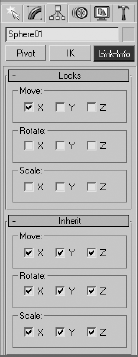
Select and move the teapot separately in the three axes. You'll see that the teapot has been locked in the X-axis and will not move at all in X. This is what a lock does to an object, no matter where it is in a hierarchy.
Select the box and move it separately in all three axes. You'll see that the teapot, except the Y-axis, moves along with the box as it should. The teapot is restricted from inheriting any motion in the Y-axis from the box parent. This is what an inheritance lock does to a child under a moving parent.
Motion Panel
The Motion panel houses all the tools for controlling animated objects using keyframes editing and animation controllers. You will have a chance to play with keyframes and controllers in Chapter 8, "Introduction to Animation." The Parameters option allows you to edit keyframes without using the Curve Editor, which is usually the preferred and more powerful way to edit keyframes (Figure 3.22).

Figure 3.22. The Parameters in the Motion panel allow you to edit keyframes of an object's animation.
The Trajectories option in the Motion panel (Figure 3.23) allows you to display the path that an object travels in its animation. This way you can actually see the movement an object takes in its animation and adjust it visually to change its course.

Figure 3.23. The Trajectories option in the Motion panel gives you a visual display of your animation's path.
Display Panel
The Display panel (Figure 3.24) allows you to choose how an object appears in your viewports. Use the Display panel to Hide/Unhide, Freeze/Unfreeze, and alter display characteristics of objects. This ability is extremely useful when you need to organize your scenes, no matter what their size.
The Hide by Category heading rollout allows you to turn off types of objects in 3ds Max to let you focus on certain objects. For example, if you have a scene replete with objects, but you only need to adjust your lights, you can easily turn off your geometry and shapes to better see where your lights are in the scene.
Hiding objects is useful for getting parts of your scene out of the way temporarily. Hiding, as it implies, turns offs the display of the hidden object. Similarly, freezing objects allows you to still see frozen objects, but not select or transform them. This feature is useful when you still need to reference a model but don't want to move it accidentally. When you freeze an object, its display in the viewports turns dark gray by default.
The larger and more complicated your scenes become, the more you can rely on the Display panel to help you with your scene.
Note
You can also use the Layer toolbar, which is covered later in this chapter, to help you organize large scenes.
Utilities Panel
The Utilities panel (Figure 3.25) allows you to access different utility programs, or plug-ins, inside 3ds Max. Some plug-ins are already shipped with 3ds Max, and some are third-party applications from various software makers. One such utility is Motion Capture, which allows you to import and work with animation data captured using external devices, such as a joystick or a midi device configured to mimic puppetry animation. These utilities are all advanced and will not be covered in this book.
Time controls, animation controls, playback controls, and viewport controls are aligned at the bottom edge of the 3ds Max UI. This section covers the icons and functions.
Running across the bottom of the 3ds Max UI are the Time slider and the track bar, as shown in Figure 3.26.
The Time slider allows you to move through any frame in your scene by scrubbing (moving the slider back and forth). By scrubbing, you can also view your animation playback in the viewports. You can move through your animation one frame at a time by clicking on the arrows on either side of the Time slider or by pressing the < and > keys.
You can also use the Time slider to animate objects by setting keyframes. A right-click on the Time slider brings up a Create Key dialog box, which allows you to create transform keyframes for the selected object. Figure 3.27 shows the Create Key window.
The track bar is directly below the Time slider. The track bar is the timeline that displays the timeline format for your scene. More often than not, this is displayed in frames, with each tick mark representing frames. On the track bar, you can move and edit your animation properties for the selected object. When a keyframe is present, right-click it to reveal individual transform values; these values can be edited within the dialog box. From this pop-up menu, you can delete keyframes and filter the Track Bar display. You will have a chance to explore using these tools in the chapters on animation in this book.

Figure 3.27. The Create Key window lets you set a keyframe for a selected object by right-clicking the Time slider.
The icon to the left of the track bar is the Mini Curve Editor icon. This toggle displays a version of the Track View Curve Editor. The Track View Curve Editor shows you your scene's animation as curves that you can edit.
The status bar in 3ds Max gives you feedback and information as you work in your scene. The status bar runs across about two-thirds of the bottom of the screen as shown in Figure 3.28. Check it out, you'll love it.
Here are the elements on the status bar.
MAXScript Mini Listener This is a command prompt used for entering and viewing feedback for MAXScript. MAXScript is the scripting language used in 3ds Max to automate actions and customize functions. This line displays a single line of the actual MAXScript Listener window, which gives you easier access in a window to MAXScript.
Status Line Displays the number and type of objects selected in your scene.
Lock Selection When your object is selected, Lock Selection lets you lock the object so you won't inadvertently deselect or select something else in your scene. The icon turns yellow when turned on. The keyboard shortcut for this tool is the spacebar.
Relative/Absolute Transform Toggle When you enter values in the Transform Type-In boxes (as you did with the Mobile exercise in the previous chapter), 3ds Max treats the values as absolute. If you set the toggle to relative, the values you enter will be used to offset the selected object from its current state.
Coordinate Display You can enter values in these boxes (delineated as X, Y, and Z values) to transform the selected object, whether it is moving, rotating, or scaling. The Coordinate Display allows you to specify exact values for transforms instead of using the gizmo. When nothing is selected and you are moving the cursor around in a viewport, the Coordinate Display area shows the coordinates of your cursor.
Grid Settings Shows the size of one grid square on the Home Grid in your viewport. To edit the size of your grid squares, go to the Grid and Snap Settings dialog box. This can be found by choosing Customize → Grid and Snap Settings (or by right-clicking the Snap Toggle tool) and clicking the Home Grid tab.
Prompt Line This line in the status bar is similar to a guy who stands behind you and taps you on the shoulder to tell you what you need to do next. Here, 3ds Max displays instructions that prompt you for the next action in a function, such as "Click and drag to select and move objects" when the Move tool is active. The Prompt Line gives you ongoing feedback as you work with a tool. It can be a good place to look when you're unsure of what to do next. In addition, Tool Tips are displayed here when you mouse over icons and buttons. Mousing around and checking icon names is a good way to become more familiar with the interface.
Adaptive Degradation This toggle helps improve performance in the viewports whenever you transform geometry, change your view, or play back an animation by decreasing the display quality of certain objects temporarily while you are making the transform or change. Only when your 3ds Max scenes become large, or your system's performance is low, will this toggle be truly handy. Right-click this icon to access the new Adaptive Degradation priority settings
Communication Center This notification system keeps you up to date on new service packs available for 3ds Max and provides information for members of the Autodesk Subscription Program. The Communication Center can give you information such as product tricks and tips and support info.
Time Tag Time Tag is an animation assistant that allows you to set up tags at a certain point in your animation that you can easily jump to by selecting the tag's name.
Animation Controls
The Animation controls are a selection of icons to the right of the status bar that are used in animation. Figure 3.29 shows the icons.
The functions of the Animation controls are covered in Chapter 8, "Introduction to Animation." The rundown on the icons is as follows:
Set Key Sets a keyframe for the selected object(s) at the current frame for all tracks of the object. A track is a specific translation type (move, rotate, and/or scale, or a parameter) on a specific axis. The keyboard hot key for Set Key is K.
Auto Key Animation Mode Toggles the Keyframing mode on and off. The icon turns red when Auto Key mode is on. Keyframes are automatically created when Auto Key icon is on and objects are transformed. You don't need to set a key manually while in the Auto Key mode.
Set Key Animation Mode You can create specific keyframes for a selected object by placing the object as you like and then setting a keyframe manually. This Animation mode, along with the Key Filters (discussed next), allows you to control exactly which tracks are keyed while you animate. With Set Key mode off, any keys you set will set for all tracks by default.
Key Filters Clicking this icon will open the Set Key Filters window shown in Figure 3.30.This window is where you can pick the tracks and the desired axis or axes you want to be keyframed as you animate. This keeps your scene free of extra keyframes you may not need.
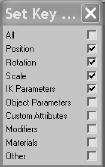
Figure 3.30. The Set Key Filters window allows you to select the keyframes for which you wanttracks set.
Selection List Gives you quick access to named selection sets and track sets while you are working with Set Key. Lets you easily swap between different selection sets and track sets.
In/Out Tangent for New Keys Shortcut for setting up tangent types for keys on curves for animation created with Set Key or Auto Key. This is only for new keyframes. Curves and keyframes are covered in detail in Chapter 8.
Animation Playback Controls
The Animation Playback controls (Figure 3.31) are similar to the ones you would find on a VCR (how old are you?) or DVD player.
Go to Start Moves the Time slider to the first frame in the active time segment.
Previous Frame/Key Moves the Time slider back one frame or one key, depending on the Key Mode toggle.
Play/Stop Plays your animation in the active viewport. The icon is a flyout that lets you access another icon (an outline of a play arrow instead of the filled black arrow) to play only the animation of selected objects instead of the entire scene.
Go to End Moves the Time slider to the last frame in the active time segments.
Next Frame/Key Moves the Time Slider forward one frame or one key, depending on the Key Mode Toggle.
Current Frame Also called Go to Frame, this field displays the current frame. It allows you to enter a frame number in the field to jump your Time slider to that frame. There is also a spinner that you can click/drag to change the frame number.
Key Mode This tool allows you to jump from one keyframe to another. In order for it to work, you must enable it and then use the Previous and Next Key icons to move from one frame to the next. When active, the Key Mode icon turns cyan, and the Previous Key and Next Key icons appear as shown in Figure 3.32.
Time Configuration A dialog (Figure 3.33) that allows control over frame rates, time display, playback, and animation. You can use this to scale your animation length so it goes faster or slower, or to add more frames to the start or end of your animation. This is covered further in Chapter 8.
Viewport Navigation Controls
The tools for viewport navigation are extensive, and many of the icons have nested flyouts that give access to multiple tools. The available tools change depending on the viewport you have selected, such as Orthographic, User (a 3D view that is created when an orthographic view is rotated), Perspective, Camera, or Light. Working with the UI is the best way to learn what tools are associated with each viewport.
When a navigation tool is selected, it turns yellow and stays selected until you choose another tool, right-click in a viewport, or press Esc.
Viewports are used for orthographic and perspective views, and also for views through cameras and lights. By setting a viewport to a view from a camera or light, you can easily position the camera or light exactly as you need it using the Viewport Navigation controls, working interactively as you watch the result in that viewport. (We will experiment with cameras and lights in later chapters in this book.)
The Navigation controls, as they appear when the Perspective viewport is active, are as shown in Figure 3.34
Figure 3.35 shows how the icons appear while an Orthographic view is active.
Figures 3.36 and Figures 3.37 show the default icons for a light and a camera, respectively.
In the following tables, all of the Navigation icons are laid out and briefly explained. The 3ds Max screen has a lot of icons, but experience will help you make sense of things very quickly. Take a look at these icons and click around to get a feel for how they work.
Create a few objects to have something to look at in your viewports, or open the Mobile exercise scene file. Spend some time poking around the viewports and looking at things. Use the Viewport Navigation controls and their key/mouse combinations to get used to navigating a bit more.
Note
The key to getting good at navigating 3ds Max, or any other 3d package, is to work on projects and get things done. You will gain the skills you need as you work toward a goal. As you will see, the exercises in the rest of this book will let you flex your muscles and give you a chance to become comfortable with 3ds Max.
The individual icons are explained in the following tables. Refer back to Figures 3.34 through Figures 3.37 to see the icons' locations on the UI.

Tools Available in All Viewports
These icons are available in all of the viewports in Figures 3.34 through Figures 3.37.
Keep in mind that some of the following icons are nested icons beneath flyouts; to reveal them you will need to click and hold the flyout icon. An example of a flyout for the Navigation controls is shown here:
ICON | NAME | FUNCTION |
|---|---|---|
Zoom Extends All | Works like the Zoom Extend tool, but lets you zoom in your scene in all four viewports. The keyboard shortcut for this tool is Z. | |
Zoom Extends All Selected | Works like Zoom Extends All for objects that you have selected. | |
Min/Max Viewport | Toggles between Normal and Full Screen viewport sizing. The keyboard shortcut is Alt+W. | |
Pan View | Lets you move the selected viewport up, down, and side to side. The shortcut Ctrl+P; you can also click/drag the middle mouse button. |
Tools Available in Perspective and Orthographic Viewports
These icons (refer back to Figures 3.34 and Figures 3.35) appear available in the Perspective and Orthographic viewports. Keep in mind that some of the following icons are nested beneath flyouts.
ICON | NAME | FUNCTION |
|---|---|---|
Zoom | Zoom magnifies the objects in your viewport from big to small by moving the view in and out of 3D space in the scene. Zoom works the same way in both the Perspective and Orthographic viewports. The keyboard shortcut is Ctrl+Alt+MM. If your mouse has a middle dial, you can use it as a Zoom tool by centering your pointer in the selected viewport and rolling the dial to zoom in and out. | |
Zoom All | Works like Zoom but lets you zoom all four viewports at once. | |
Zoom Extents | This flyout icon works like a "Fit to Window" function because it zooms all objects in your scene into the viewport. It only works for Orthographic and Perspective viewports. | |
Zoom Extents Selected | This flyout icon is nested with Zoom Extents. It works like the Zoom Extents tool for selected objects only. | |
Field-of-View (FOV) | This flyout icon nested with Zoom Region is available in the Perspective or Camera. FOV changes the amount of the scene that you can see in the viewport by adjusting the field of view. It zooms in and out like a camera lens. (This is not the same as Zoom, which moves the view in and out of the scene.) | |
Zoom Region | This flyout icon nested with Field of View allows you to drag a rectangle marquee around the area you want to zoom in on. This tool is available only in Orthographic/User and Perspective viewports. | |
Walkthrough | This flyout icon is nested with Pan View (the hand icon). This very cool tool lets you move through a viewport by pressing the arrow keys. It is similar to the Pan tool, but you use the arrow key for navigation instead of the mouse. When you enter the Walkthrough Navigation mode, the pointer changes to a hollow circle that shows a directional arrow while you are pressing one of the arrow keys. Walkthrough is available only for Perspective and Camera viewports. | |
Arc Rotate | This flyout Icon is nested with Arc Rotate Selected and Arc Rotate SubObject. Arc Rotate lets you rotate a viewport by clicking and dragging a series of handles on the gizmo (shown in Figure 3.38). Uses the viewport center as the center for its rotation. The shortcuts are Alt+MM and Ctrl+R. | |
Arc Rotate Selected | This flyout icon is nested with Arc Rotate and Arc Rotate SubObject. This icon has a white circle. It works like Arc Rotate but uses the selected object as the center for rotation. The object remains in the same position as the viewport rotates around the object. | |
Arc Rotate SubObject | This flyout icon is nested with Arc Rotate and Arc Rotate Selected and has a yellow circle. It works similarly to Arc Rotate Selected, but it rotates about the current SubObject selection. |
Camera Viewport Controls
A camera view shows your scene through the lens of a virtual camera. These tools control the Camera viewport. The specific tools available will change depending on whether you are using a Free or Target camera. (Cameras are covered in Chapter 11.)
Again, use this section as a reference, and click along with the descriptions. You don't need to memorize it all or understand everything at once. You can come back to this chapter when you need to look up something.
To access these navigation tools, you will need to create a camera and switch a viewport to its view. To create a camera, follow these steps in a new scene or a current scene:
Choose Create → Cameras → Free Camera, and click in one of your viewports to place the camera. You may also click in the Create panel under the Cameras category and click the Free icon. Figure 3.38 shows a camera placed in the scene.
Right-click a viewport name in the upper-left corner of the viewport, and select Views → Camera01, as shown in Figure 3.39. This will change the viewport to the camera's view. You will now be able to access the Camera Viewport navigation tools shown in the following table.
Now that you have created a Free Camera in your scene, click the following icons as you explore to see how they'll help you navigate in a Camera viewport. Some of these navigation icons apply to a Target camera only, and several of these icons are flyouts nested with other icons:
Light Viewport Controls
This set of tools shows your scene through the perspective of a light. This may seem a bit unusual, but it can be very useful for exact positioning of your lights. Some tools for the light objects have the same names (Dolly, Roll, Truck, Orbit and Pan) and are used the same way as the Camera navigation tools. Therefore, their icons are not repeated here. However, the Light Viewport controls that are specific to lights are listed.
You will need to create a light in your scene to access these icons in the Viewport Controls section of the UI. To create a light in the scene, follow these steps:
Choose Create → Lights → Standard Lights → Free Spotlight and click in one of your viewports to place the camera. You may also click the Create panel under the Lights category, and click the Free Spot icon. Figure 3.40 shows a light placed in the scene.
Right-click a viewport name in the upper-left corner of the viewport, and select Views → Fspot01, as shown in Figure 3.41. This will change the viewport to the light's view. You will now be able top access the Camera Viewport navigation tools shown in the following table:
ICON | NAME | FUNCTION |
|---|---|---|
Light Hotspot | Lets you adjust the angle of the light's hotspot, which is the brightest part of the circle of light. | |
Light Falloff | Lets you adjust the angle of the light's falloff, which is the light fading to the back of the circle of light. |
Light Viewport controls help you place your lights just the way you want them. (You'll get more hands-on experience with lights in Chapter 10, "3ds Max Lighting.") If you are getting sick of looking at icons, remember that nearly all viewport navigation
If you are getting sick of looking at icons, remember that nearly all viewport navigation tasks can be performed using the keyboard shortcuts and the mouse buttons. This rich set of navigation tools gives you many options for moving around in 3D space, but you needn't really worry about any of them until you are comfortable just getting around—and by now this should be coming easier to you.
Navigating Viewports
The easiest way to navigate the viewports is to use the keyboard/mouse button combinations you used in the previous chapter while working on the Mobile exercise. Here is a review of these keyboard/mouse actions.
Pan Panning a viewport will "slide" the view around the screen. MM+click in the viewport and drag the mouse to move the view.
Zoom Zooming will move your view in closer or farther away from your objects. To zoom, use the middle wheel, or press Ctrl+Alt and MM+click in your viewport, and then drag the mouse up or down to zoom in or out, respectively. Zooming is called dollying in some other packages, and zoom sometimes is used to refer to the virtual camera's lens.
Arc Rotate and Arc Rotate Selected Arc Rotate and Arc Rotate Selected let you rotate your view around your objects. To use either of the two Arc Rotate tools, press Alt and MM+click and drag in the viewport. Use Shift+Alt+ MM for constrained rotation. By default, 3ds Max will rotate (or tumble as it's called in some other CG programs) about the center of the viewport to change your perspective. However, if an object is selected, 3ds Max will revert to Arc Rotate Selected, which will rotate about the center of the selected object instead of the center of the viewport. This way the object remains in the same position as the viewport rotates around the object.
Viewports are where 3D space is simulated. Viewports in 3ds Max are always set up with four equally sized views when you first start (Top, Front, Left, and Perspective viewport). One will have a yellow highlighted border, which shows that this viewport is the selected view. You can activate a view by working in it or by right-clicking in it. (Be careful about left-clicking because if something is selected, it will be deselected.)
You can also resize your viewports by centering the pointer over the splitter bars that separate the views. It will change to a four-sided arrow, and you can click/drag the viewports to the size desired. To switch the viewport layout back to the default, right-click over the center splitter bars. A pop-up tag with "Reset Layout" will allow you to go back to the default.
Let's not forget the Min/Max Viewport tool in the navigation area (its hot key is Alt+W). This will change the equally sized views into one full-screen view of the active viewport.
One way to change the default look of your viewports is to use the Viewport Configuration/ Layout dialog box. You can find it by choosing Customize → Viewport Configuration and clicking the desired layout, as shown in Figure 3.42.
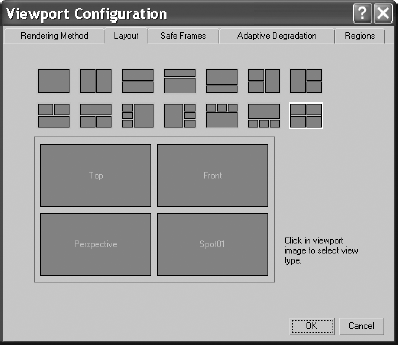
In each of the viewports, the axes are displayed in the lower-left corner of the World Space tripod. The axes are always displayed in red, green, and blue format to represent the X-, Y-, and Z-axes respectively, as seen in the Perspective viewport. You have seen this familiar color scheme at work in the gizmos as well.
You've undoubtedly noticed the Home Grid in your views by now. This grid is a ground plane that centers around the Origin (0,0,0). The Home Grid tab lets you set the spacing of your Home Grid.
The Home Grid is a helper for construction of objects. When you create a new object, it is placed on the grid. The Home Grid's defaults can be edited for more effective scene creation, and they can be turned on and off easily by right-clicking the viewport name to access the pop-up menu. In that menu, you will see Show Grid. Click the grid to toggle it on and off. To use the keyboard shortcut to toggle the grid, press G.

The grid displays the units of your scene. The default is set up as Max Units where one unit equals 1 inch. Each grid division is 10 units. The best approach is to choose a grid spacing that matches your unit of measurement. For example, if you are using centimeters, make one grid square equal 1 centimeter. To access the Grid dialog box, choose Customize → Grid and Snap Settings, and click the Home Grid tab as shown here.
Changing Viewport Views
As you saw earlier, the viewports are flexible and can be changed to different displays by right-clicking on the viewport name and choosing the new viewport from the menu (Figure 3.43).
This lets you change which view you have in a viewport. You can also use keyboard shortcuts to access any of the viewports. In an active viewport, press the hotkey for the desired view. Hot keys are listed in this table:
HOTKEY | VIEW |
|---|---|
T | Top |
B | Bottom |
F | Front |
L | Left |
C | Camera |
P | Perspective |
U | User or Axonometric—a 3D view without perspective |
These keys are extremely helpful when one viewport is maximized and you need to access different views quickly. For scenes that have more than one camera, press the C key to bring up a pop-up menu from which you can select the camera. With so many ways to change viewport views, you'll be able to find the way that works best for your workflow.
Note
Because the R shortcut enables the Select and Scale tool, there is no keyboard shortcut for the Right viewport.
Viewport Rendering Levels
Viewports let you view your scene in a few different ways. For example, in the Mobile exercise, you saw how you can switch between Wireframe and Smooth + Highlight Shaded views. How you view objects in a viewport is referred to as viewport rendering. Again, you can access a different viewport rendering method by right-clicking the viewport's name, as shown in Figure 3.44. Depending on the size of your scene, your viewport may be more responsive and have a less-taxing rendering display level than the one shown here.
Each of the viewport rendering levels has specific properties.
Smooth+Highlights Displays scene objects with smooth shading and specular highlights from the scene lights. This gives the best feedback for your objects.
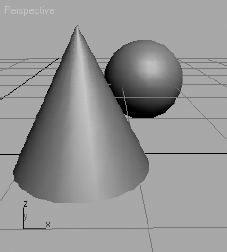
Smooth Displays objects with no highlights and only smooth shading.

Facets+Highlights Displays scene objects with flat shading and displays specular highlights. This is a fast way to see your solid objects with highlights when Smooth+ Highlights is too taxing with heavy scenes.

Facets Displays polygons as flat surfaces that are shaded, but includes no smoothing or scene highlights.

Flat Displays each polygon in its raw diffuse color, disregarding any scene lighting or light sources. This viewing method is useful when you need to see each polygon rather than to see their shading.
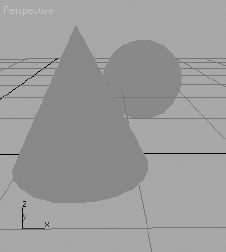
Hidden Line A Wireframe mode that allows you to use the Wireframe mode without seeing through every object. In this display mode only, the wireframe color is determined by choosing Customize → Customize User Interface in the Colors tab under Elements → Viewports and selecting Hidden Line Unselected rather than the object or material color.

Lit Wireframes Displays objects as their wireframes with a flat shading for a sense of lighting.
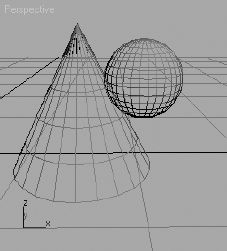
Wireframe Draws objects as wireframes only. This is the fastest viewing method that still lets you see an object's shape.

Bounding Box Displays objects as bounding boxes. Bounding boxes are approximations of the amount of volume a shape occupies. No shading is applied.

Note
3ds Max 2008 will automatically degrade the display of certain objects variably (such as using bounding boxes) when the geometry in a complex scene is too much for the display to handle when the viewport is being moved. You probably will not encounter this feature, called Adaptive Degradation, until you begin dealing with very large scenes. You can disable Adaptive Degradation by pressing the keyboard shortcut O.
Edged Faces Edged Faces draws the wireframe of an object back onto its shape when it is displayed in one of the shaded modes (Smooth, Smooth+Highlights, Facets+Highlights, or Facets). Edged Faces lets you see the wireframe lines and faces of an object for easier editing, while still seeing it shaded.
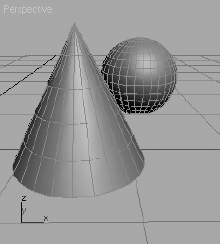
Setting the viewport rendering levels will help you with larger scenes. More often than not, viewing your scenes with the Smooth+Highlights mode will give you the best feedback.
With the new Adaptive Degradation features in 3ds Max 2008, you won't need to worry about which rendering level you choose. The levels are designed to automatically adapt when your systems responsiveness is slower because of a larger scene.
Gizmos
Using gizmos is a fast and effective way to transform your objects with interactive feedback. As you saw in the Mobile exercise in the previous chapter, gizmos let you manipulate objects in your viewports interactively to transform them—i.e., translate (move), rotate, and/or scale. Coordinate Display boxes at the bottom of the screen display coordinate or angular or percentage information on the position/rotation/scale of your object as you transform it. The gizmos appear in the viewport on the selected object at their pivot point as soon as you invoke one of the transformation tools.
After you invoke the Move tool by pressing W (or accessing it through the toolbar), your gizmo should look like this:
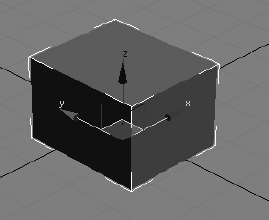
The XYZ-axis gives you handles to move an object on one specific axis. You can also click on the box between two axes to move the object in that plane, which is shown here as YZ:
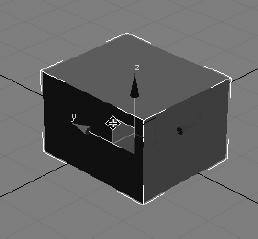
If you invoke the Rotate tool by pressing E, your gizmo will turn into three circles as shown. You can click on one of the circles to rotate the object on the axis only, or you can click anywhere between the circles to freely rotate the selected object in all three axes.

Invoke the Scale tool by pressing the R key, and your gizmo will turn into a triangle, as shown here:
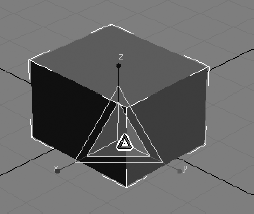
Clicking and dragging anywhere inside the yellow triangle will scale the object uniformly in all three axes. By selecting the red, green, or blue handles for the appropriate axis, you can scale along one axis only. You can also scale an object in a plane between two axes by selecting the side of the yellow triangle between two axes as shown here along the Y- and Z-axes:

Keep in mind that the gizmos appear at an object's pivot point; therefore, if there is an object where you have relocated the pivot point away from the object itself, the gizmo will appear there and not on the object itself, as shown here where the rectangle's pivot is to the right of the object.
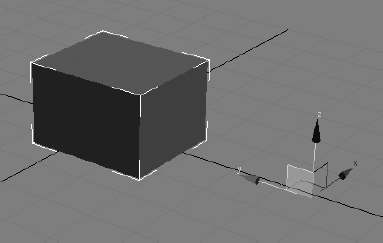
In the following graphic, a cube is being transformed in the Y-axis. The Coordinate Display box indicates how much it is being moved.
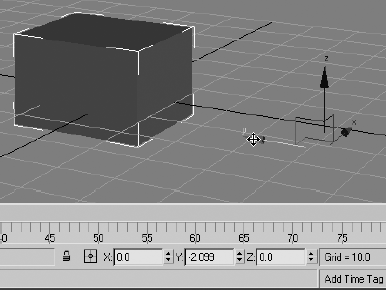
3ds Max has a few ways to organize and manage your scene elements to make working with things easier. These tools include the Layer Manager, the Schematic View, the Material Editor, and the Curve Editor/Dope Sheet. The Layer Manager works with objects to organize them in layers. The Schematic View allows you to view, manage, and edit your scene's hierarchies. The Layer Manager and Schematic View windows are outlined for you here, and they are used extensively throughout this book.
The Material Editor allows you to manage your scene's materials and textures. The Material Editor is covered in Chapter 7, "Materials and Mapping." The Curve Editor manages the animation in your scene by giving you access to animation curves. The Dope Sheet manages the animation in your scene by giving you access to animation ranges or sets of keys. The Curve Editor is covered in Chapter 8, and the Dope Sheet is covered in Chapter 9.
Layer Manager
The Layer Manager can be accessed through the main menu: Tools → Layer Manager or through the Main Toolbar icon
Layers can be used to organize scene objects. In 3ds Max, layers are organized similarly to Photoshop layers; you can organize different elements of an image in separate layers. Layers are mainly used to control object visibility, default color, selecting, freezing, and hiding. All of these functions help you organize your scene and make object management easier. You will use the Layer Manager in future exercises in this book.
The icons across the top of the Layer Manager are explained here.
Create New Layer Creates a new layer when you have objects selected in your scene. The selected objects are assigned to the new layer.
Delete Highlighted Empty Layers Deletes selected layers if they are empty.
Add Selected Objects to Highlighted Layer Moves currently selected objects into the selected layer.
Select Highlighted Objects and Layers Selects all highlighted objects, as well as all objects contained in any highlighted layers.
Highlight Selected Objects' Layers Highlights layers containing the currently selected objects and automatically scrolls so that highlighted layers are visible in the Layer Manager.
Hide/Unhide All Layers Enables the display of all layers.
Freeze/Unfreeze All Layers Enables the frozen state of all layers.
The columns in the Layer Manager window itself are the following:
Layers Displays the names of the layers/objects. To select or rename a layer, click its name. To display object or layer properties, click the object icon to open the Object Properties dialog box for all highlighted objects.
Current Layer Toggle The unlabeled column to the right of the layer name indicates the current layer. The check mark next to a layer means it is selected and current. This feature lets you make a different layer current.
Hide Hides and unhides layers. When a layer is hidden, it's invisible.
Freeze Freezes layers. Frozen layers can not be selected.
Render When this feature is enabled, objects appear in the rendered scene. Nonrendering objects won't cast shadows or affect the visual component of the rendered scene.
Color Changes the default color on highlighted objects.
Radiosity When this feature is enabled, objects are included in the radiosity solution.
Using the Layer Manager
The Layer Manager can be extremely useful for organizing and managing your scene objects. You will use the Layer Manager throughout the rest of this book. Let's take a quick look at how the Layer Manager can help you with a scene.
Open a new scene and create four new objects as shown here: a box, a sphere, a cone, and a torus.
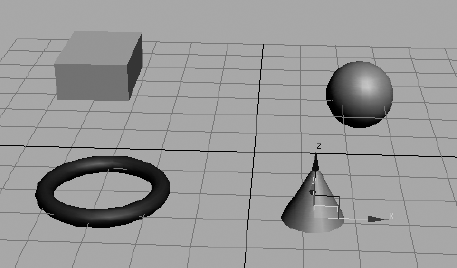
Open the Layer Manager by choosing Tools → Layer Manager or by clicking the Layer Manager icon (

Note
To select more than one object in a viewport, press the Ctrl key as you click on additional objects to add to your selection. Many applications use the Shift key to add to a selection; however, 3ds Max uses Ctrl.
In the viewport, select the box and the sphere and assign them to Layer01 by selecting Layer01 and clicking the Add Selected Objects To Highlighted Layer icon


As you did in step 3, assign the cone to Layer02. Select Layer01 and turn on Freeze. The sphere and box will turn gray in the viewport and you will no longer be able to select them. Click Hide, and the box and sphere will disappear from the viewports.
Experiment with toggling Hide and Freeze for the objects or the layers so that you can see how your scene reacts when they are on and off.
The Schematic View is another way to organize and manage your scene, particularly object hierarchies. This window displays the objects in your scene in a flowchart scheme, allowing you to see how objects are linked or grouped together. Parents connect down the flowchart to their children. This method of viewing hierarchies is powerful, because you get an immediate visualization of how the objects in your scene work and relate to each other.
While we're talking about hierarchies, let's return to the Mobile exercise from the previous chapter and see how the Schematic View depicts the scene. Figure 3.46 shows the Mobile scene in the Schematic View.

Figure 3.46. The Mobile scene broken down in the Schematic View immediately tells you how the objects are organized.
A scene can become so complicated that trying to select one object is impossible. The Schematic View makes editing character rigs easier, allowing you to view, create, and edit links between objects. The Schematic View simplifies the selection process by clearly displaying every object in the scene as a box with the object's name displayed in it. You can use the middle mouse button to pan around in the Schematic View, or you can use any of the familiar navigation icons found in the lower right-hand corner of the window, as shown in Figure 3.46.
When you select any object in the schematic, its parameter automatically appears in the Modify panel for easy editing. Because objects can have different states of being, different conventions are used to indicate an object's current state in the scene, with the more important states listed here:
Red Border The object is animated.
White Fill The object is currently selected in the Schematic View window.
White Border The object is currently selected in a viewport.
Up Arrow Used to simplify a view. Pressing the Up arrow collapses each node and its dependent child nodes up to the next highest parent, putting everything into one node for simpler display. This is useful for large characters and long hierarchy chains because you don't have to see all the child nodes in a large scene. This does not remove the hierarchy; it only affects the display.
Down Arrow Used to gain more information about a group of objects. Clicking the down arrow expands the next child down from that node to show you its immediate child node(s).
In the Mobile scene, you can see how the Main Parent node runs the show. It is the top bar of the mobile; the second row of bars hangs from it as its children with the shapes on the Mobile hung below them.
The toolbar across the top of the Schematic View is used for editing hierarchies in your scene. We will experiment with reordering the Mobile hierarchy in the Schematic View in just a moment. First, let's look at the tools as called out in Figure 3.46.
Display Floater Enables the Display Floater window, which gives you access to display toggles for certain object types in the Schematic View.
Select Allows you to select objects in the Schematic View. When you select an object in a viewport, its node in the Schematic View will be outlined in white. However, it will not necessarily be selected in the Schematic View. If you want to be able to select an object in either window once and have it selected in both the Schematic View and the viewports, choose Select → Sync Selection in the Schematic View window.
Connect To create links in the Schematic View, just as you created links between objects in the Mobile project, click the child object and drag it to the desired parent.
Unlink Selected To break links between objects, click the child to unlink and then click this icon.
Delete Objects Deletes the selected object(s) from the scene. If you make a mistake, you can press the Undo icon in the main toolbar or press Ctrl+Z to get the object(s) back.
Hierarchy Mode Lays out the Schematic View as an outline view, as shown here.

Reference Mode Lays out the view in the Schematic View, as shown here. This view is good for viewing object relationships and materials.
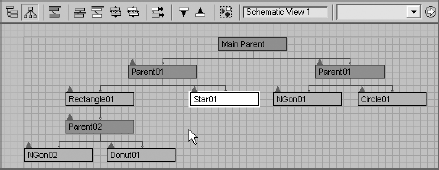
Always Arrange The Schematic View will keep the node display rigid. As you see in the Reference Mode graphic, you will not be able to freely move nodes around. Turning this Always Arrange mode off allows you to arrange the nodes any way you want, as shown here.

The next group of icons—Arrange Children, Arrange Selected, Free All, and Free Selected—all have to do with automatically arranging nodes when you turn off Always Arrange.
Move Children When you click and drag a node, all of its child nodes will follow it when this mode is enabled.
Expand/Collapse Selected Used to reveal or hide the child nodes of the selected node.
Preferences In the Preferences window for the Schematic View, you can filter certain object types (such as lights, cameras, objects, etc.) from displaying in the schematic.
Schematic View Name Field Lets you save certain views to recall later for easy access. When you have a heavy scene, with tons of nodes to view, getting to the right place in a complicated hierarchy can take some time. When you type a name for your current view into this text box, 3ds Max will save the view for you. To access that particular view again, in the main menu bar, select Graph Editors → Saved Schematic Views → Schematic View Name. See Figure 3.47.
Bookmark Name Field Lets you define a selection of nodes in the Schematic View with bookmarks that you can later return to easily.
Using the Schematic View with the Mobile
Let's take a look at the Schematic View in action, and have another whack at the Mobile scene's hierarchy.
With your Mobile scene loaded, open the Schematic View by choosing Graph Editors → New Schematic View or by clicking the Schematic View (Open) icon

Unlink the Star object from the Mobile and relink it to the Circle object. To do this, click the Connect button and then select the Star01 node and drag it to the Circle01 node, as shown in Figure 3.49.
When you release the mouse button, notice that the Star01 node is linked under the Circle01 node, as shown in Figure 3.50. The Star has been automatically unlinked from its old parent.
You can see how easy it is to restructure your scene hierarchies using the Schematic View. All the controls for viewing and arranging nodes might be a bit much for one window. You probably won't need half those icons, but knowing how to use the Schematic View is important. It is an important tool in organizing and setting up your scenes for animation. You will continue to use the Schematic View throughout this book.
New to 3ds Max 2008 is the Scene Explorer dialog (Figure 3.51). This window is accessed through the Tools → New Scene Explorer and is an expanded version of the dialog opened with the Select by Name icon in the 3ds Max toolbar as discussed earlier in the chapter. Scene Explorer allows you to view the objects in your scene by name, as well as sort or filter them by type, view and edit their hierarchies, and generally manage the objects in your scene. Through the Scene Explorer you can rename, delete, hide, freeze, and edit some object properties en masse.
Two primary uses of the Scene Explorer are to select objects and edit their hierarchies. To select objects in your scene in Scene Explorer, enable Sync Selection by clicking its icon in the Scene Explorer toolbar, as shown in Figure 3.51. While it is enabled, if you select an object in your scene through a viewport, it is simultaneously selected in the Scene Explorer and vice versa.
You can link and unlink objects to edit hierarchies as well. If you drag an object's icon onto another object in the Scene Explorer dialog until you see a yellow arrow to the left of the target object, the dragged object will become a child of the target object. To unlink an object, drag its icon from the target object in the Scene Explorer to the Scene Root node at the top of the list.
You can have as many Scene Explorer windows open as you like because they persist in your scene as you work. You can toggle between different views of the Scene Explorer that you have opened previously through the window's View Explorer pull-down menu.
Wow! That was a lot of information. You've learned how to navigate the menus, toolbars, icons, panels, and windows in 3ds Max. Remember, don't worry about absorbing all that information. This chapter exists to give you a unified reference guide for 3ds Max UI issues. Come back to this chapter as you work with 3ds Max on the tutorials in this book and any other 3ds Max work you have.
If you've read all the way through this chapter, you've seen the icons and buttons you will come across most often, and have had a taste of everything on the main 3ds Max UI screen and a brief description of what each feature does.
Complete understanding of how to use 3ds Max comes with time and experience. To develop that understanding, you need to work on projects that further challenge you and get you moving around inside the UI. This book begins that ride and tries to give you a good push in the right direction. Take everything in this chapter with a grain of salt and head into the coming chapters.



